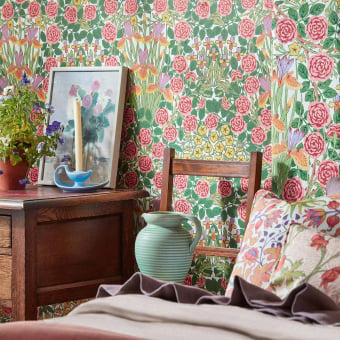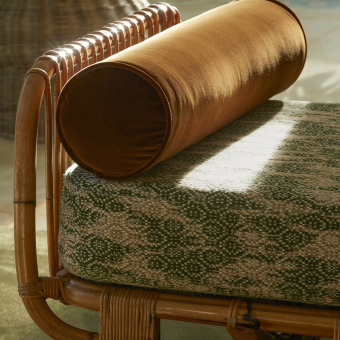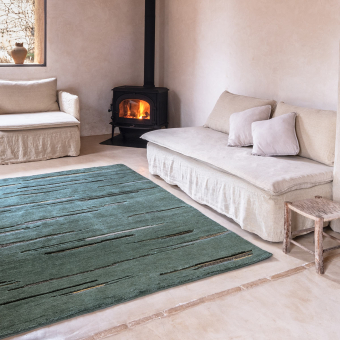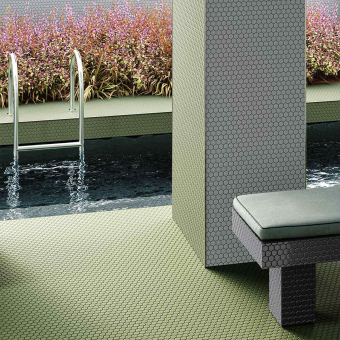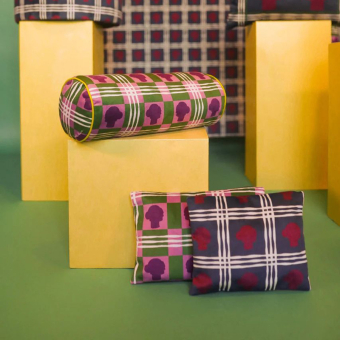Rug care
Rugs are intended to be used and walked on. For this reason they require special care in order to extend their lifespan.
CONTENTS:
General tips:
- Regularly change the position of your rugs by rotating them or altering the space between them to avoid them changing in a uniform fasion.
- Air them out each season.
- Avoid prolonged direct contact with humidity.
Anti-slip strips:
Particularly useful for fine rugs, anti-slip strips not only prolong the life of your rug, but also prevent accidents by holding the rug nicely in place.
Potential repair:
It may be possible to repair a knotted rug if damaged. It is thus possible to catch the torn or detached threads, edges and small holes, but also the restore the colours of worn surfaces. This type of repair can be carried out by an expert.
Washing:
As a general rule, washing your rug once a year will suffice, although the frequency can vary. The majority of rugs can be washed more frequently if required, without any risk.
- New rugs
The majority of rugs are washed prior to being made available for sale. This washing fixes the colours and enables the monitoring of the quality of the rug. As a safety measure, it is nonetheless advised that you have new carpets dry cleaned rather than washing in water, to avoid colours fading or bleeding and staining the whites.
- Old carpets
They can be washed with water or dry cleaned, it makes little difference. However, washing in water delivers better results.
Regular care:
Because not all rooms are exposed to contamination in a uniform manner, the frequency at which rugs require cleaning varies depending on the use of the room. Your rug can be regularly cleaned using a broom corn broom, or a vacuum cleaner is the rug is sufficiently durable. If necessary, the rug can be beaten with a carpet beater by laying it out over the end of a bed and beating it first on the front and then on the reverse side.
During the first few weeks rug, and in particular wool rugs, "break in". That is, they cast off surplus fibres. In any case, you should avoid vacuuming your rug too regularly as this risks damaging it, and you should avoid shaking it too violently, which could distort the weave and alter the shape of the edges.
Restoring colour and shine:
To make certain rugs brighter and to restore the colours, there is an old technique that involves cleaning the rug with tea leaves rolled up in a clean cloth. The tea can also be replaced with ammonia, white vinegar or trichloroethylene diluted in water. Be careful not to soak the rug: you have to blot the rug with a barely damp cloth. Remember that this is a light clean that does not take the place of washing.
Thorough cleaning:
If you want to steam clean the rug, make sure that it has been thoroughly vacuumed. If you fail to do so, the dust may be retained and absorbed by the fibres, before solidifying upon contact with the steam. A spray-extraction cleaner is perfectly suitable for deep cleaning and offers the advantage that it restores the original appearance of the rug without soaking it too much. You can also sprinkle wool carpets with baby powder. Leave the powder to act for several hours ( or even better, overnight), then run the vacuum over it. Dry foams can also be used, but a certain degree of caution is required. Chemical preparations that could damage the fibres in the long term must not be left on the rug.
Wool rugs
- Prior to washing the rug, perform a test on a corner of the rug using a cotton but to verify that the product is compatible with the rug. If colour comes off onto the cotton bud or if the colours of the rug bleed, you would be better having the rug dry cleaned.
- Rub over with a cloth dampened with warm soapy water, with a few added drops of ammonia.
- Allow the product to soak in.
- Rub over with a cloth dampened with hot water.
- Blot wool rugs with a dry cloth.
Silk rugs
- Avoid accessively aggressive drying.
Consult a rug specialist or have it dry cleaned.
Cotton rugs
- Wash small cotton rugs in the washing machine.?
- Because of their weight when wet, it is difficult to wash large cotton rugs.
- Shampoo them with foaming products or simply with natural household soap and water.
- Rinse.
- Dry.??
Felt rugs
- The care of felt carpets does not pose any problems.
Run the vacuum cleaner over them, and for a deeper clean use a shampoo without too much water.
Synthetic rugs
- Use a special shampoo on rugs and fitted carpets with synthetic fibres.??
- Carry out a deep clean around every two years using a spray-extraction machine.
Moths and dust mites
- Regularly clean your rug to avoid it become a trap for dust mites or worse, moths, which could pose a real threat. There is a particularly high risk if the rug is covered by an item of furniture for a long period of time which prevents cleaning, or if it is placed in a room that is continually exposed to dust.
- If a rug has to be put into storage, the storage area must be cool and dry. The rug should be rolled in newspaper or another form of protection as a preventive measure and camphor or naphtalene slipped inside. You should also avoid prolonged storage for more than a year where possible.
Humidity
- Humidity absorbed on a continual basis and over a long period of time damages the fibres that form the basis of the rug, that is, the weave and weft, irreparably, which causes it to teat at each wet spot. The typical example: a vase or a plant placed on the rug without waterproof protection: in a few weeks the area beneath and around the vase will become damaged.
- If the rug becomes marked, white soap, salt, lemon juice, vinegar solution or bicarbonate of soda can perform miracles.
- You can also blot the area with a cloth dampened with 10-volume peroxide or ammonia.
Furniture marks
- Remove or lighten traces left by heavy furniture by holding your hot steam iron a centimetre above the crushed pile. The steam will fluff them up, especially if you do it just after vacuuming or combing.
Pet hairs
- Get rid of hairs by rubbing the fabric by hand, while wearing a rubber glove. The hairs form a ball that can be easily removed.
- A damp synthetic sponge is also very effective.
Burn marks
- If the burn on the rug is superficial:
- Get rid of the burnt fibres by brushing vigorously.
- Rub the black area with a piece of sugar.
- Erase light burn stains by blotting with a cloth dampened with water and some added peroxide (5 parts water to one part peroxide).
- If necessary cut the burnt rug pile then lighten the stain by blotting with a cotton cloth soaked in 20-volume peroxide.
- If the burn is more severe:
- Replace the burnt surface of the rug.
- Remove all traces of black by scraping.
- Apply a little glue at the bottom of the hole.
- Very carefully detach a few piles from a less visible section and glue them to the hole until it looks full.
- Do not walk on the rug until the glue is completely dry!
Stains on a rug
Stains on rugs are something that are bound to happen, especially if the rug is positioned in an entrance or lounge.
- Good news regarding wool rugs: the fabric retains a small amount of natural grease which makes it pretty much waterproof.?
- A brush will suffice to remove certain superficial stains.
- The majority of stains resistant to brushing will disappear with a normal detergent.
- Always treat a stain working from the edge towards the centre to prevent it from spreading.?
- Never apply the product directly onto the rug. Use a clean cloth and apply using a dabbing action.
- Dry without rubbing using a clean cloth or a hair dryer.?
Recent stains
- Blot recent stain as soon as possible with an absorbent paper before it can penetrate to the core of the fibres.
- If it's too late, run a sponge dampened with slightly soapy water over the stained area, using circular motions.
Old stains
- Don't rush!
- Begin by vacuuming to remove dust from the rug or fitted carpet before removing the stain. This will avoid a ring forming.
Stains of unknown origin
- If you cannot get rid of a stain of unknown origin on a rug or fitted carpet, try removing the stain by blotting with a cloth soaked in an anti-rust product, if that don't work try peroxide and finally ammonia.
- Rinse off the products following each stain removal treatment using a damp sponge.
Chocolate
- Clean the stain using cold water.
- If the stain is crusted on, scrape of the dried in chocolate.
- Blot the rug or fitted carpet using a cloth dampened with soapy water.
- If the stain persists, rub it using a cotton cloth dampened with diluted benzene or ammonia or even white vinegar.??You can also allow warmed glycerine to soak into the stain.
- You must rinse the treated area with warm water.
Blood
- Recent stains:
- Dampen the stained area with cold water.
- Set the rug on a hard surface the gently rub with the round part of an iron key.
- If necessary blot the stains with a cloth soaked in slightly diluted ammonia and then potentially with peroxide as well. Saline solution also achieves good results.
- Persistent stains:
- Clean using tartaric acid, peroxide or ammonia. You can also use a mix of water and corn starch (or flour or talc).
- You must rinse after stain removal.
- Old or encrusted stains:
- Use water with added soda crystals or peroxide.
- You must rinse the cleaning agent off.
Excrement
- Rinse the stains immediately in warm water.
- If this is not possible, remove the stains be blotting with a cloth dampened with slightly diluted ammonia.
- On rugs or fitted carpets made from natural fibres, use water with added alcohol vinegar.
Vomit
- Rinse the stains immediately in warm water.
- If this is not possible, remove the stains by blotting with a cloth dampened with slightly diluted ammonia or peroxide.
- On rugs or fitted carpets made from natural fibres, use water with added alcohol vinegar.
- If there is a lingering odour, sprinkle over a thin layer of bicarbonate of soda once the stain has been removed and the rug is dry.
- Leave it to act overnight.
- Run the vacuum cleaner over it in the morning.
Wine
- Never use salt: it fixes stains!
- Sprinkle the wet stain with corn starch or baby powder.
- Brush then blot the dried stain using a cloth dampened with milk.
- Then wipe with a little soapy water.
- Recent stains:
- Blot with a clean cloth
- Immediately wipe with a sponge dampened with carbonated water.
- Old stains:
- Wash with vinegar or cold water.
- If the task persists, soak it with warm milk or vinegar for one hour, or longer if necessary.
- Rinse.
Fizzy drinks
- Recent stains
- Sprinkle the stains with flour, or better yet, baby powder.
- Brush the rug or fitted carpet once the stained section has dried.
- If necessary blot with a cloth soaked in a little soapy water.
- Old stains:
- Blot the stain with a cloth dampened with methylated spirits or water with added ammonia.
- You must rinse the cleaning agent off.
- On a rug or fitted carpet with synthetic fibres:
- Wipe over with a cloth dampened with 20-volume peroxide.
- Rinse with bleach solution and then with warm water.
- On a rug or fitted carpet made from natural fibres:
- Rub with natural household soap, without water.
- Allow to act for a few hours.
- Wash, then rinse.
Coffee
- Apply warmed glycerine to the stain. You can also use a mixture of water and alcohol (50/50) and then acetic acid (25%) or sodium perborate.
- Rinse with a weak vinegar solution.
- On a rug or fitted carpet with synthetic fibres:
- Wipe the stain with a cloth dampened with glycerine or 90° proof alcohol solution.
- Rinse with warm water.
- Dry.
- On a carpet made from natural fibres: blot the stain with a cloth soaked in ammonia and glycerine solution (1 part glycerine to 6 parts water).
Tea
- Recent stains:
- Wash with soapy water.
- Rinse with vinegar solution.
- Old stains:
- Wash using warmed glycerine and soapy water.
- On rugs or carpets with synthetic and artificial fibres:
- Remove stains using lemon juice. A mixture of white vinegar and 90 percent proof alcohol or sodium perborate will also do the job.
- Rinse.
Red fruit
- Apply a cloth soaked in lemon juice.
- You must rinse the cleaning agent off.
Nail polish
- Avoid the use of solvents.
- Remove these stains using acetone./li>
Perfume
- Blot the stain with a cloth dampened with white vinegar or wipe gently with glycerine.
- Wash
Glue
- Act as quickly as possible, ideally before the glue dries.
- Soak the stain in white vinegar.
- Then blot it with a cloth dampened with warm water.
Felt-tip pen
- On rugs made from natural fibres:
- Blot the stain with a cloth soaked in lemon juice.
- Once the stained area has dried, repeat until the stain disappears completely.
- On artificial and synthetic fibres:
- Blot the stain with a cloth soaked in vinegar solution (except on acetate).
- Wash
- Rinse.
Ink
- Remove these stains by soaking them in milk, a mixture of lemon juice and salt or toothpaste.
- If the stain persists, wipe it gently with a cloth dampened with peroxide.
- On rugs or carpets made from natural fibres:
- Spray on 90° alcohol or alcohol vinegar solution. Hairspray can also prove very effective.
- Wipe immediately using a clean cloth.
- Repeat until the stain has disappeared completely.??
- On rugs or carpets with synthetic fibres:
- Blot the stained area immediately with lemon juice.
- Rinse.
- Repeat the process if necessary or try the Corrector
- Wipe with glycerine.
- Allow to act for half an hour.
- Rinse carefully with hot water.
Coloured ink
- Lighten the stain by applying a thin layer of mustard.
- Allow it to act for an hour or two.
- Wipe dry.
- Rinse.
Oil paint
- Carefully remove any excess from the stain using a spoon.
- Blot the stained area with a cloth soaked in solvents appropriate for this type of paint. Generally speaking, white spirit is used.??
- If the stain persists:
- Use a fatty substance such as lard.
- Leave to act for a day.
- Remove with a cloth dampened with turpentine oil.
- Use a product for cleaning ovens if necessary, and with care.
- Leave to act for 1/4 hour.
- Wipe.
- Do not forget to use your hands using rubber gloves.
Gloss paint
- Blot the paint stains with a cloth dampened with turpentine oil.
Mud
- Leave the sludgy paint to dry and then brush off.
- Wash any remaining traces with soapy water.
- On rugs and carpets made from natural fibres:
- Use ammonia solution (1 soup spoon per litre of water) or lemon juice solution.
- Wipe gently.
- Rinse
Plaster
- Scrape gently.
- Blot with a cloth soaked in vinegar.
Rust
- Make these stains disappear using water with a few drops of hydrochloric acid.
- Rinse.
- ? Alternative method:
- Point a mixture of lemon juice and salt over the stain.
- Wipe.
- Pour on powder detergent dampened with a little water,.
- Wipe once again.
- Rinse.
- If the stain persists:
- Soak it in an anti-rust product.
- Rinse well.
Candle wax
- Gently scrape off the stain with a spatula or spoon.
- Place blotting paper or a paper towel over the remaining stain and run a hot iron over it. Adjust the temperature of the iron in accordance with the fabric recommendations.
- Keep replacing the paper until the wax had been absorbed.
- If there is still a grease stain, apply a cloth soaked in benzene
Chewing gum
- Col the chewing gum with a plastic bag full of ice cubes.
- Remove the excess solidified stain with a spoon or spatula.
- If there are still grease stains on the rug or carpet, remove these with a solvent such as benzene.
- Alternative methods:
- Gently scrape off the stain with a spatula or spoon.
- Place blotting paper or a paper towel over the remaining stain and run a hot iron over it.
- Adjust the temperature of the iron in accordance with the fabric recommendations.
- Repeat the process if necessary.
- If there is still a grease stain, apply a cloth soaked in benzene
- If you prefer you can use alcohol vinegar.
Plasticine
- Gently scrape off the stain with a spatula or spoon.
- Place blotting paper or a paper towel over the remaining stain and run a hot iron over it. Adjust the temperature of the iron in accordance with the fabric recommendations.
- Repeat the process if necessary.
- If there is still a grease stain, apply a cloth soaked in benzene
- Rinse.
Makeup
- Never soak a grease or make-up stain.
- Get rid of them using benzene or ammonia.
- If there is still a ring, sprinkle it with talc, chalk or baby powder. Alternative method
- Gently scrape off the stain with a spatula or spoon.
- Place blotting paper or a paper towel over the remaining stain and run a hot iron over it. Adjust the temperature of the iron in accordance with the fabric recommendations.
- Repeat the process if necessary.
- If there is still a grease stain, apply a cloth soaked in benzene
Shoe polish
- Remove any excess with a spatula or spoon.
- Remove the stains with benzene, turpentine oil or even white spirit.?? You can also blot the stained carpet or rug with a cloth soaked in lighter fluid or a mixture of lemon juice and salt.
- Alternative method
- Apply glycerine to the stain.
- Leave to act for 1/4 hour.
- Rinse with hot water.
- If the stain persists:
- Soak it with white vinegar.
- Rinse.
- Repeat with glycerine.
Soot
- Sprinkle the stain with talc.
- Brush.
Oil
- Remove the excess from the stain with a spoon or spatula. If necessary, soften it with a greasy substance.
- Blot with a cloth soaked in lemon juice solution, benzene, white spirit or turpentine oil.
- Rinse.
- Dry.
Help
In case of doubt contact us on 01 83 62 07 91 for specialist advice.
 France (Mainland and Corsica)
France (Mainland and Corsica)
 France (Mainland and Corsica)
France (Mainland and Corsica)












